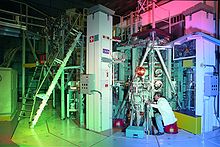Tokamak à configuration variable
| Tokamak à configuration variable | |
|---|---|
 TCV in 2002 | |
| Device type | Tokamak |
| Location | Lausanne, Switzerland |
| Affiliation | École Polytechnique Fédérale de Lausanne |
| Technical specifications | |
| Major radius | 0.88 m (2 ft 11 in) |
| Minor radius | 0.25 m (9.8 in) |
| Magnetic field | 1.43 T (14,300 G) |
| Heating power | 4.5 MW |
| Plasma current | 1.2 MA |
| History | |
| Year(s) of operation | 1992–present |


The Tokamak à configuration variable (TCV, literally "variable configuration tokamak") is a Swiss research fusion reactor of the École Polytechnique Fédérale de Lausanne (EPFL). As the largest experimental facility of the Swiss Plasma Center,[1] the TCV Tokamak explores the physics of nuclear fusion by magnetic confinement. Its distinguishing feature over other tokamaks is that its torus section is three times higher than wide. This allows studying several shapes of plasmas, which is particularly relevant since the shape of the plasma has links to the performance of the reactor. This asset has earned its choice as one of the three national machines in Europe involved in the design of the international reactor ITER,[2] as well as in the development of ITER’s successor DEMO, a prototype of a commercial reactor. The TCV was set up in November 1992.
Characteristics[]
- Plasma height: 1.40 metres
- Minor radius: 0.25 metre
- Major radius: 0.88 metre
- Plasma current: 1.2 megaamperes
- Plasma life span: 2 seconds maximum
- Toroidal magnetic field: 1.43 teslas
- Additional heating power: 4.5 megawatts
Main studies[]
- Confinement studies
- confinement as a function of the shape of the plasma (triangular, square or elongated)
- Improvement of the confinement of the core
- Studies on vertically elongated plasmas
- Studies with ECRH and ECCD (electron cyclotron resonance heating and )[3]
By 2012 it had 16 poloidal plasma shaping coils and could achieve a variety of field configurations and plasma shapes.[4][5]
History[]
- 1976: First proposal for an elongated tokamak by the "New Swiss Association"
- 1985: Second proposal, with a more elongated tokamak
- 1986: Acceptance of the TCV proposal (Tokamak à Configuration Variable)
- 1992: First plasma discharge
- 1997: World record of plasma elongation (see plasma shaping)
- by August 2015 it has had a 19-month shutdown/upgrade to install its first neutral beam injector.[6]
- by 2016 it was upgraded/enhanced to run with a 'snowflake' divertor[7]
References[]
- ^ "Swiss Plasma Center (SPC) | ETH-Board". www.ethrat.ch. Retrieved 2020-12-08.
- ^ "Swiss Plasma Center: a new name for a strengthened role". ITER. Retrieved 2020-12-08.
- ^ TCV Auxiliary Heating.
- ^ TCV - Development of new plasma shapes. May 2012
- ^ [1] diagram shows 16 shaping coils and 7 other poloidal coils
- ^ Keeping fusion research on the boil: Three tokamaks and one stellarator. August 2015
- ^ Snowflake and the multiple divertor concepts. March 2016
External links[]
| Wikimedia Commons has media related to Tokamak à Configuration Variable. |
- TCV official site
- TCV Technical data as of Oct 2012
- Tokamaks
- École Polytechnique Fédérale de Lausanne